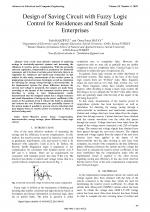| 4/2010 - 16 |
Design of Saving Circuit with Fuzzy Logic Control for Residences and Small Scale EnterprisesBASCIFTCI, F. |
| Extra paper information in |
| Click to see author's profile in |
| Download PDF |
Author keywords
reactive power factor, compensation, microcontroller, energy savings, phase difference, fuzzy logic control
References keywords
power(11), link(5), factor(5)
No common words between the references section and the paper title.
About this article
Date of Publication: 2010-11-30
Volume 10, Issue 4, Year 2010, On page(s): 99 - 102
ISSN: 1582-7445, e-ISSN: 1844-7600
Digital Object Identifier: 10.4316/AECE.2010.04016
Web of Science Accession Number: 000284782700016
SCOPUS ID: 78649710774
Abstract
One of the most effective methods of achieving savings in electrically-operated systems and increasing the efficiency is reactive power compensation. With the presently enforced regulation, compensation is mandatory for industrial consumers and it is done at certain power intervals, there is no regulation for residences and small scale enterprises on this subject. In this study, measurement of the reactive power in single-phase systems has been developed, as well as calculation for directing for energy saving through a microcontroller. In the implemented system, the phase difference between the current and voltage is measured, the outputs are made fuzzy according to the amount of the consumed reactive power and directing to saving is done Implementation results demonstrated that the designed system has a simple structure and small dimensions, it brings up the power coefficient of the system to the optimum level, it reduces the faults to minimum and reduces the cost. Furthermore, the portability feature of the system makes it possible to prevent adverse situations that may happen when no reactive power is consumed or when no device is being used. |
| References | | | Cited By |
Web of Science® Times Cited: 2 [View]
View record in Web of Science® [View]
View Related Records® [View]
Updated 3 weeks, 6 days ago
SCOPUS® Times Cited: 2
View record in SCOPUS® [Free preview]
View citations in SCOPUS® [Free preview]
[1] Modeling, Simulation, and Computer Control of a High-Frequency Wood Drying System, Stolic, Predrag, Stevic, Zoran, Petronic, Sanja, Nikolic, Vojkan, Stevic, Misa, Kreculj, Dragan, Milosevic, Danijela, Electronics, ISSN 2079-9292, Issue 1, Volume 12, 2023.
Digital Object Identifier: 10.3390/electronics12010226 [CrossRef]
[2] Phase difference measurement of low-frequency sinusoidal signals based on LabWindows/CVI, Haodan, Lei, Yuqing, Hou, Sheng, Tang, 2017 13th IEEE International Conference on Electronic Measurement & Instruments (ICEMI), ISBN 978-1-5090-5035-2, 2017.
Digital Object Identifier: 10.1109/ICEMI.2017.8265973 [CrossRef]
Disclaimer: All information displayed above was retrieved by using remote connections to respective databases. For the best user experience, we update all data by using background processes, and use caches in order to reduce the load on the servers we retrieve the information from. As we have no control on the availability of the database servers and sometimes the Internet connectivity may be affected, we do not guarantee the information is correct or complete. For the most accurate data, please always consult the database sites directly. Some external links require authentication or an institutional subscription.
Web of Science® is a registered trademark of Clarivate Analytics, Scopus® is a registered trademark of Elsevier B.V., other product names, company names, brand names, trademarks and logos are the property of their respective owners.
Faculty of Electrical Engineering and Computer Science
Stefan cel Mare University of Suceava, Romania
All rights reserved: Advances in Electrical and Computer Engineering is a registered trademark of the Stefan cel Mare University of Suceava. No part of this publication may be reproduced, stored in a retrieval system, photocopied, recorded or archived, without the written permission from the Editor. When authors submit their papers for publication, they agree that the copyright for their article be transferred to the Faculty of Electrical Engineering and Computer Science, Stefan cel Mare University of Suceava, Romania, if and only if the articles are accepted for publication. The copyright covers the exclusive rights to reproduce and distribute the article, including reprints and translations.
Permission for other use: The copyright owner's consent does not extend to copying for general distribution, for promotion, for creating new works, or for resale. Specific written permission must be obtained from the Editor for such copying. Direct linking to files hosted on this website is strictly prohibited.
Disclaimer: Whilst every effort is made by the publishers and editorial board to see that no inaccurate or misleading data, opinions or statements appear in this journal, they wish to make it clear that all information and opinions formulated in the articles, as well as linguistic accuracy, are the sole responsibility of the author.



